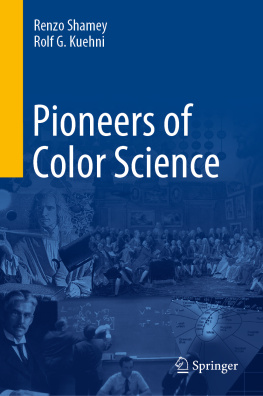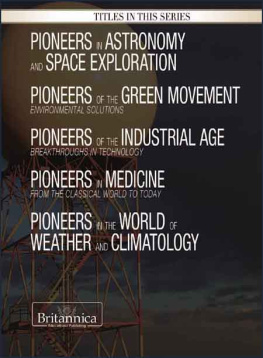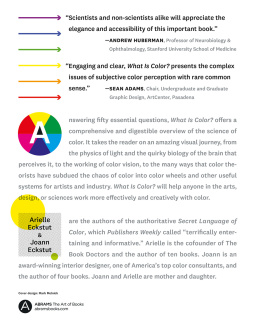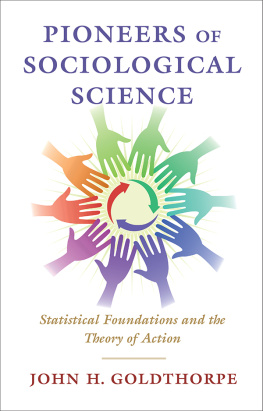Renzo Shamey - Pioneers of Color Science
Here you can read online Renzo Shamey - Pioneers of Color Science full text of the book (entire story) in english for free. Download pdf and epub, get meaning, cover and reviews about this ebook. publisher: Springer International Publishing, genre: Art. Description of the work, (preface) as well as reviews are available. Best literature library LitArk.com created for fans of good reading and offers a wide selection of genres:
Romance novel
Science fiction
Adventure
Detective
Science
History
Home and family
Prose
Art
Politics
Computer
Non-fiction
Religion
Business
Children
Humor
Choose a favorite category and find really read worthwhile books. Enjoy immersion in the world of imagination, feel the emotions of the characters or learn something new for yourself, make an fascinating discovery.
- Book:Pioneers of Color Science
- Author:
- Publisher:Springer International Publishing
- Genre:
- Rating:3 / 5
- Favourites:Add to favourites
- Your mark:
- 60
- 1
- 2
- 3
- 4
- 5
Pioneers of Color Science: summary, description and annotation
We offer to read an annotation, description, summary or preface (depends on what the author of the book "Pioneers of Color Science" wrote himself). If you haven't found the necessary information about the book — write in the comments, we will try to find it.
Pioneers of Color Science — read online for free the complete book (whole text) full work
Below is the text of the book, divided by pages. System saving the place of the last page read, allows you to conveniently read the book "Pioneers of Color Science" online for free, without having to search again every time where you left off. Put a bookmark, and you can go to the page where you finished reading at any time.
Font size:
Interval:
Bookmark:
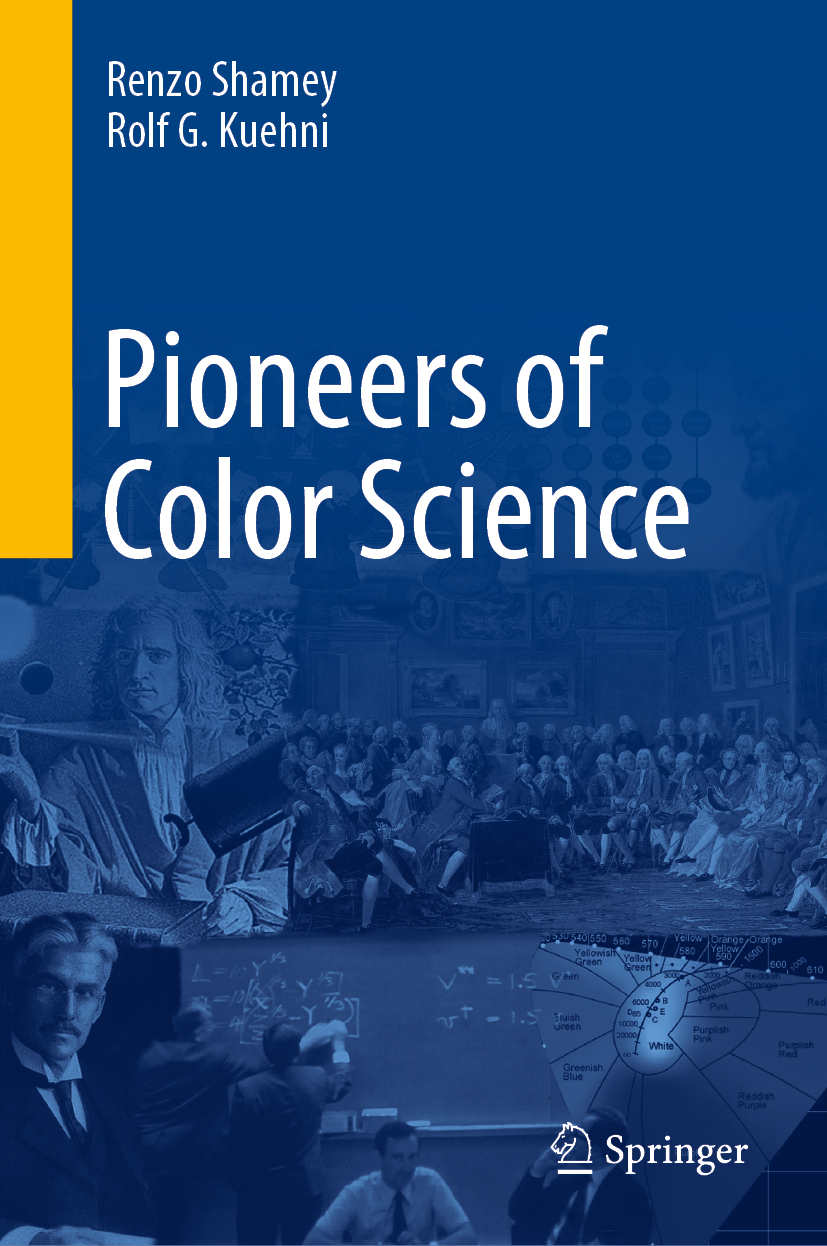

This Springer imprint is published by the registered company Springer Nature Switzerland AG
The registered company address is: Gewerbestrasse 11, 6330 Cham, Switzerland
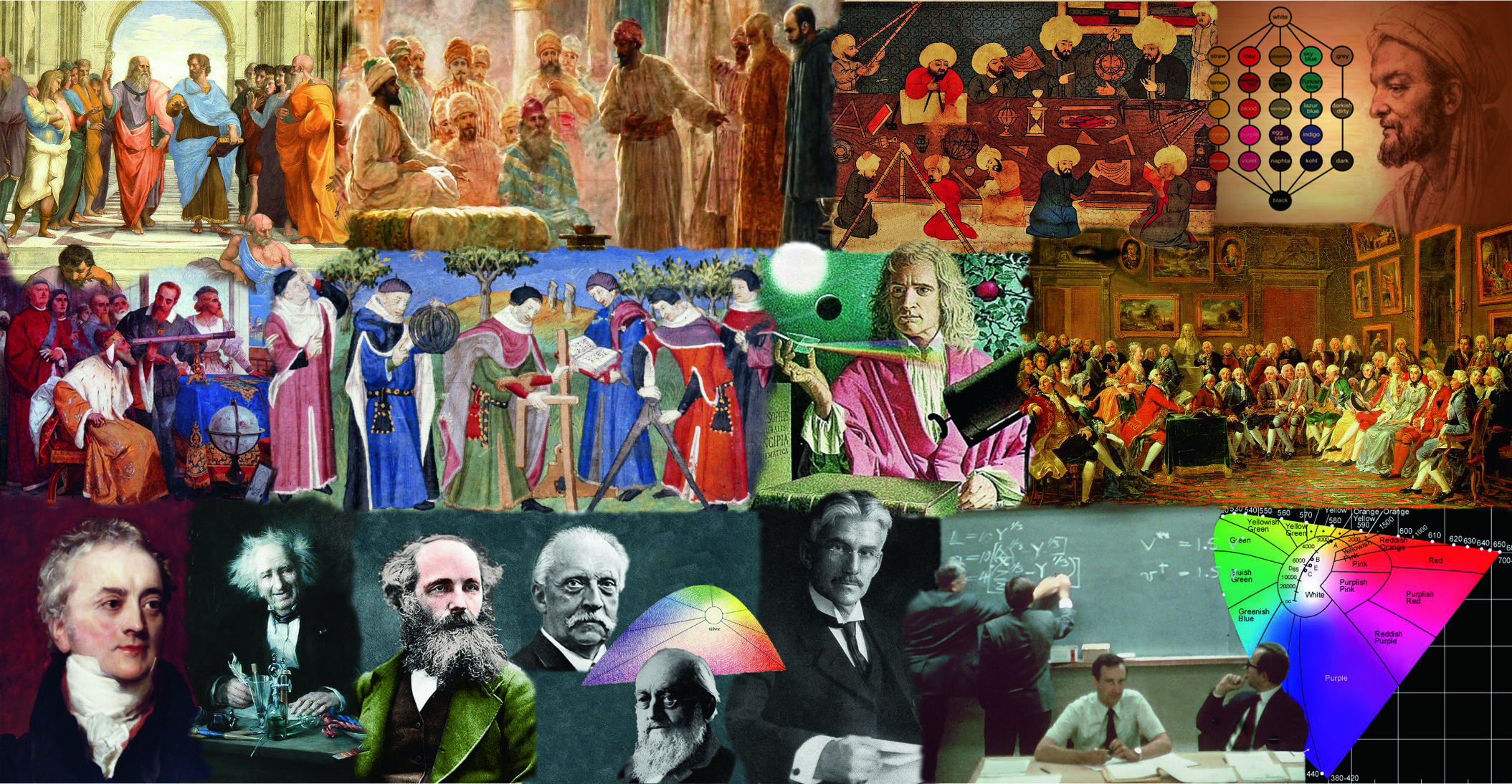
The cover collage (by R. Shamey) depicts historical progress in the general domain of science including some of the important pioneers in the field of color science. The majority of images are available in the public domain. A brief description of the images from top left to bottom right is given below.
Top Row
1. The famous School of Athens by Raphael, painted between 15101511 CE, depicting all of the major philosophers of antiquity with Plato and Aristotle at the center (Vatican Museums, Rome).
2. Abd al-Rahman III and his court receiving the ambassador in Medina Alzahara, by Dionisio Baixeras Verdaguer (18621943)University of Barcelona Virtual Museum.
3. Dar Al-Hikmah, The Museum of Science and Technology in Islam, Istanbul. Picture from Nikos Niotis.
4. The color order system according to Nasir al-din Tusi (12011274), Persian scientist.
5. Portrait of Ibn Sina (Avicenna) circa 9801037, Persian polymath.
Middle Row
1. Galileo Galilei showing the Doge of Venice how to use the telescope, by Giuseppe Bertini (18251898).
2. Landscape with clerks studying astronomy and geometry, showing an armillary sphere, square, compasses, etc., La Vraye Histoire du Bon Roy Alixandre (The Alexander Romance in Old French prose) by Pseudo-Callisthenes, early fifteenth century.
3. Portrait of Sir Isaac Newton (16431727), English polymath, by Jean-Leon Huens (19211984).
4. Reading of Voltaires LOrphelin de la Chine (a tragedy about Ghengis Khan and his sons, published in 1755), in the salon of Madame Geoffrin (Malmaison, 1812), by Anicet Charles Gabriel Lemonnier (17431824).
Bottom Row
1. Portrait of Thomas Young (17731829), English physicist, From Life of Thomas Young (1855), George Peacockfrontispiece.
2. Michel-Eugne Chevreul (17861889), French chemist, taken in 1889.
3. James Clerk Maxwell (18311879), Scottish physicist. Circa 1875, Photograph by Stefano Bianchetti/Corbis Historical (1900).
4. Hermann Ludwig von Helmholtz (18211894), German physiologist.
5. Karl Ewald Konstantin Hering (18341918), German physiologist.
6. Albert Henry Munsell (18581918), American artist.
7. Photograph of a CIE Meeting (from left to right: Ernst Ganz, David MacAdam, Alan Robertson, Gunter Wyszecki), by Fred Billmeyer.
8. CIE chromaticity diagram.
Dedicated to my son Sean Araz Luca Shamey
Color plays an important role in our daily lives. Among our sensory qualities, color has historically attracted the greatest level of interest. The idea behind this book was conceived several years ago based on experiences gained from teaching color science and technology to undergraduate and graduate students. In the course of teaching, it was increasingly felt important to provide students with an opportunity to relate to the individuals behind discoveries. Thus, whenever a discovery or invention was mentioned, a brief description of the achievements together with a depiction (whenever possible) of the individual(s) was shown to introduce the scientist and signify their contribution in the field. The idea to generate a list of pioneers in the field was thus formed. Through conversations and consultations with colleagues, an initial list was created. A survey was then placed on social media sites to collect opinions from those interested in the domain, and a final list was generated.
In the meantime, the authors were placed in charge of the People section of the Encyclopedia of Color Science and Technology (Luo, 2016). There seemed to be a strong synergy between the two activities, and it became evident that many of the pioneers selected for the book could also be included in the reference encyclopedia. A number of expert individuals were invited to contribute manuscripts to the encyclopedia. When appropriate, the authors were asked for permission to incorporate their modified manuscripts in this book. These contributions enriched the book and enhanced the quality of this project. This work provided the authors with an opportunity to (re)discover some facts and interesting information about many of the pioneers listed which are now shared with the reader. The lives and works of pioneers generally reflect the ambition of man to discover unknowns and address the challenges associated with visual perception in general and color specifically. As might be expected, the journey included controversies and heated debates.
The book contains a brief description of lives and scientific discoveries of 93 pioneers in the field of color science. It is arranged in five parts according to the following plan.
Part I covers ancient Greece which in the Western World was the source of thinking about color. Essays include discussions and views from Plato, Aristotle, and Ptolemy.
Part II involves scientific contributions in the field during the Islamic Golden Age which extended from Spain to the Far East through Persia. Major discoveries included advances in optics, vision, and categorization of color by scientists such as Alhazen, al-Tusi, Avicenna, al-Farisi, among others.
Part III is a short essay on discussions pertaining to color in the Middle Ages leading to the Renaissance. Only two notable individuals, Bacon and Dietrich von Freiberg, are recorded to have made significant contributions to this domain over the period.
Font size:
Interval:
Bookmark:
Similar books «Pioneers of Color Science»
Look at similar books to Pioneers of Color Science. We have selected literature similar in name and meaning in the hope of providing readers with more options to find new, interesting, not yet read works.
Discussion, reviews of the book Pioneers of Color Science and just readers' own opinions. Leave your comments, write what you think about the work, its meaning or the main characters. Specify what exactly you liked and what you didn't like, and why you think so.

